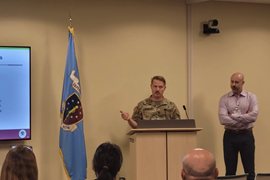The Armed Forces Health Surveillance Division’s Global Emerging Infections Surveillance branch hosted its first Next-Generation Sequencing Summit in Silver Spring, Maryland. Attendees included representatives from the GEIS network of global partner laboratories and other U.S. government agencies. AFHSD is a division of Defense Health Agency Public Health.
“This meeting was our first effort of bringing together, in-person, the world class level of sequencing and bioinformatic expertise within the GEIS partner network,” said U.S. Navy Cmdr. Matthew Kasper, chief of the GEIS branch. “These discussions are critical in the GEIS program’s support of the priorities detailed in the 2023 Biodefense Posture Review.”
The presentations covered a variety of topics, including sequencing capabilities and challenges throughout the GEIS network; the Pathogen Detection Project, a blinded panel proficiency test assessing all aspects of unbiased sequencing and bioinformatics methods; bacterial pathogen sequencing; data operationalization, and topics such as wastewater surveillance and pathogen agnostic sequencing.
 U.S. Army Capt. William Kowallis from the Defense Centers for Public Health-Aberdeen presented on wastewater surveillance for infectious diseases during the first day of the Next-Generation Sequencing Summit. The summit occurred in September 2023. (DOD photo)
U.S. Army Capt. William Kowallis from the Defense Centers for Public Health-Aberdeen presented on wastewater surveillance for infectious diseases during the first day of the Next-Generation Sequencing Summit. The summit occurred in September 2023. (DOD photo)At the beginning of the COVID-19 pandemic, the GEIS network leveraged its existing sequencing capabilities through the GEIS Next-Generation Sequencing and Bioinformatics Consortium to rapidly pivot focus and scale up sequencing of SARS-CoV-2- positive samples. The resulting shift in capabilities allowed for close monitoring of SARS-CoV-2 variants within the Military Health System and in relevant locations for service members around the globe.
Now, public health professionals say that the infectious disease surveillance community has an opportunity to adjust priorities and further explore emerging technologies and methods that became increasingly available during the pandemic, such as pathogen agnostic sequencing and wastewater surveillance.
Experts also add that increased capabilities of Department of Defense medical and public health laboratories allow experts to detect and characterize infectious disease threats before they become widespread. These emerging technologies and methods can provide critical information to enhance early warning of biothreats as noted in the 2023 Biodefense Posture Review.
According to DOD public health officials, during the acute phase of the COVID-19 pandemic, wastewater surveillance was used to monitor increased community transmission of the virus.
They say the entire process of such surveillance–from collecting the samples to processing and performing the scientific analysis of those samples—is particularly challenging. Conference participants discussed best practices for wastewater surveillance, led by experts from the Defense Centers for Public Health-Aberdeen.
Public health experts say that determining how to successfully implement wastewater surveillance may eventually have other useful public health applications, such as tracking antimicrobial resistance—which the Centers for Disease Control and Prevention defines as what happens when germs like bacteria and fungi develop the ability to defeat the drugs designed to kill them.
Each session sparked in-depth discussions, fostered connections between GEIS partner laboratories, and opened avenues for interagency collaborations.
DOD public health officials also added that the GEIS program office, in coordination with the NGSBC, will continue to refine priorities for sequencing and genomic surveillance. They say that outcomes of these discussions will inform the future of the GEIS strategy and the strategic direction for the GEIS branch in the context of the larger DOD public health and biosurveillance initiatives.
“The summit serves a critical function to inform and expedite the next generation of sequencing technology,” said U.S. Air Force Col. Patrick Kennedy, chief of the DHA Public Health’s Armed Forces Health Surveillance Division. “As good stewards of tax dollars, we can leverage the capabilities of our partners, while minimizing redundancy where possible.”
Learn more about the GEIS program at the Global Emerging Infections Surveillance website.